In this article, you will learn 14 B2B SEO best practices that actually work in 2025 and will help you drive more B2B leads, and increase organic traffic the and ranking of your website.
And the more B2B SEO best practices and tips you implement for your website, the better results you can expect. So, make sure you check out all the best practices to maximize your SEO results.
Why SEO is Important for B2B?
B2B SEO is one of the most effective lead sources to generate high-quality B2B sales leads for your company on a consistent basis. It helps companies specifically target users searching for their products or services instead of blindly targeting potential B2B customers hoping that someone might be interested.
This means you can bring users that are searching for you instead of you searching for them. Therefore, a B2B SEO strategy is considered an inbound marketing strategy as you let people come to you when they need you.
Of course, there are many more reasons why SEO is important for B2B brands, but here you can find the two most important reasons.
To Generate More & High-Quality Leads
57% of B2B marketers say that SEO generates more leads than any of their other marketing initiatives, 59% of B2B marketers say SEO has the biggest impact on their lead generation goals and SEO leads have a 14.6% close rate, compared to only 1.7% for outbound leads such as print advertisements. Learn more about B2B SEO Statistics.
And we could carry on with these statistics, but the fact is that SEO can generate most of your B2B leads for your business and they can be of the highest quality.
In fact, for companies in the SaaS space, focusing on SaaS lead generation through SEO can result in a significant boost in high-quality leads.
In my experience, B2B brands that started focusing on SEO lead generation have always improved their lead generation results and get more music for their bucks.
It’s also an extremely effective way to increase your email subscriber list to start with B2B email marketing for lead generation.
However, it can be a long-term game. Therefore, before you see any results, you might need to focus on other B2B lead generation strategies.
To Diversify Lead Generation
And the second reason why SEO for B2B is so important is that it helps you to diversify your lead generation effort.
The internet offers answers to all of our questions and provides important information we need to make a business decision.
Your B2B target audience is searching on the internet to solve their problems and learn more about products or services they intend to purchase.
That’s why B2B SEO is important because your B2B buyers are looking for your products or services to solve their problems.
Whether they are at the beginning or the end of your buying journey, you can bring them to your website and start generating leads.
That’s why B2B SEO should be a part of your lead generation and brand awareness efforts in order to meet your business objectives.
Best Practices, Tips & Tricks for B2B SEO
With that, B2B SEO is essential for your business, and you should start with it rather sooner than later. That’s why I have prepared for you this list of best practices, tips & tricks for B2B SEO:
1. Create Topical Authority for Money Pages
The first and for me, one of the most important B2B SEO best practices is to create topical authority for your money pages as this will help you increase your ranking for important profitable keywords and generate a lot of high-quality leads.
This works on a very similar principle of topic clusters created by HubSpot.
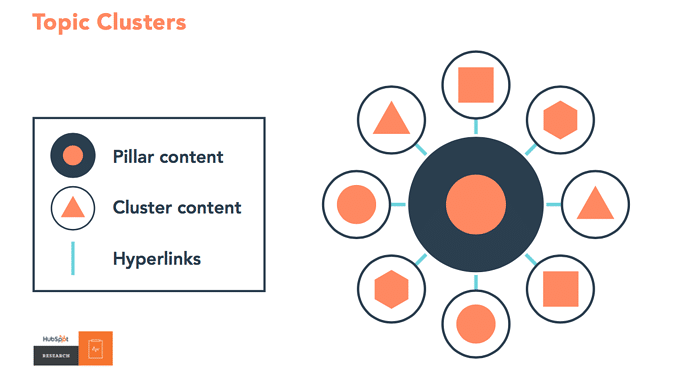
For example, let’s say you are selling and project management system, and of course, you want to rank in the top position for the category keyword “project management system” in SERPs.
So, to achieve that, you will need to create a topic cluster for the project management, by targeting as many related keywords such as “project management”, “project management techniques”, “project management templates”, “project management courses”, “best project management softwares”, et cetera.

Then you will want to create semantically related internal links from all these articles to your money page and of course between each other.

And after that, you will want to build backlinks to these articles so you can start ranking in the top-ranking positions, as like this you will send a strong topical signal, that you are an expert in the project management field or whatever you are in.

And lastly, you will want to expand beyond the topic cluster keyword targeting and cover everything there is to project management such as the waterfall method, critical path method, project costs, and project plan, you got the idea.

Because, you must remember, to rank in the top positions, Google needs to trust you, they need to see you as an expert and authority in a particular field. Part of this trust comes from a well-executed link building plan, especially when it comes to B2B link building or saas link building.
To do that, you need to target as many keywords related to your niche as possible and build high-quality backlinks to it.
That’s why focusing on semantic SEO and building topical authority in your field is so important if you want to drive great results from your B2B SEO.
2. Map Keywords to Buyer Journey
The next on this list of B2B SEO best practices is to map keywords to the buyer journey.
When B2B buyers are typing a certain keyword into the search bar, it means they are looking for something.
Sometimes it is information on how to do something, learn new things, or even learn more about products or services they want to purchase all the way to actually making a purchase.
This is called search intent and by understanding the search intent behind each keyword, you can map keywords to buyer journey so you can drive your B2B target audience to your website across all stages.
Because you just don’t want to be driving any organic traffic, but ultimately traffic, that could be potentially interested in your offering. Whether it is now or later.
For example, if you look at this infographic, you can see an example of a B2B company selling CRM software and how to map keywords to each stage of the buyer journey.

For example, you can see how the search intent is changing. Clearly, the informational search intent contains a lot of keywords you would use to learn more or get information.
Then once a user starts using the commercial search intent type of keyword, it starts showing that the user could be interested in CRM and start searching for different CRM software that could fit his/her needs.
And lastly, the transactional search intent type of keywords clearly displays that the user is ready to make a purchase and is using keywords to do so.
That’s why, by mapping your industry-related keywords, you will be able to attract users across all these stages and maximize your B2B SEO potential.
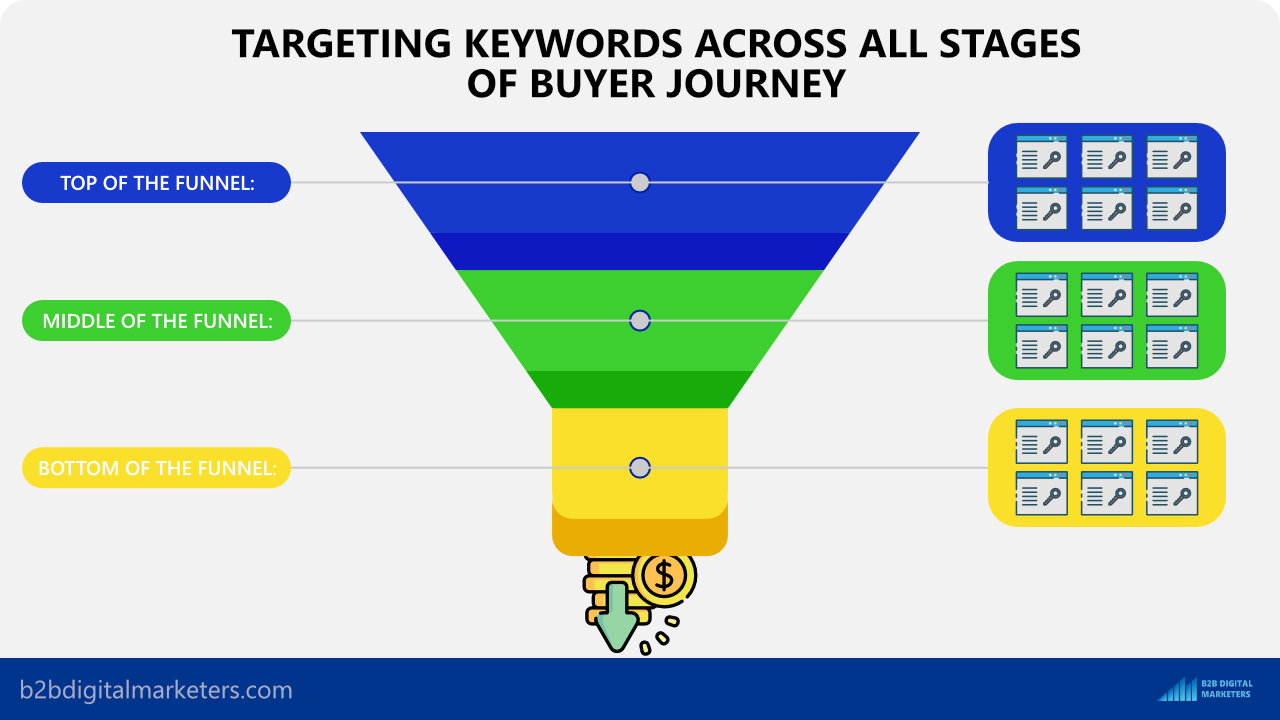
You will also be able to attract those users that fit your ideal prospects even before they start searching for your solution. Because early exposure to your brand could make a difference in why a prospect selects your company instead of your competitors.
For example, HubSpot is selling CRM software and their ideal prospects are people in marketing, sales, and customer service.

So, they write a ton of articles about sales, marketing, or customer service even if it has nothing to do with CRM because if those people start searching for CRM systems in the future, past exposure could help them increase trust so they request for more information, demo, or even buy their product.
That’s why they are able to generate 10,000s SEO leads every month.
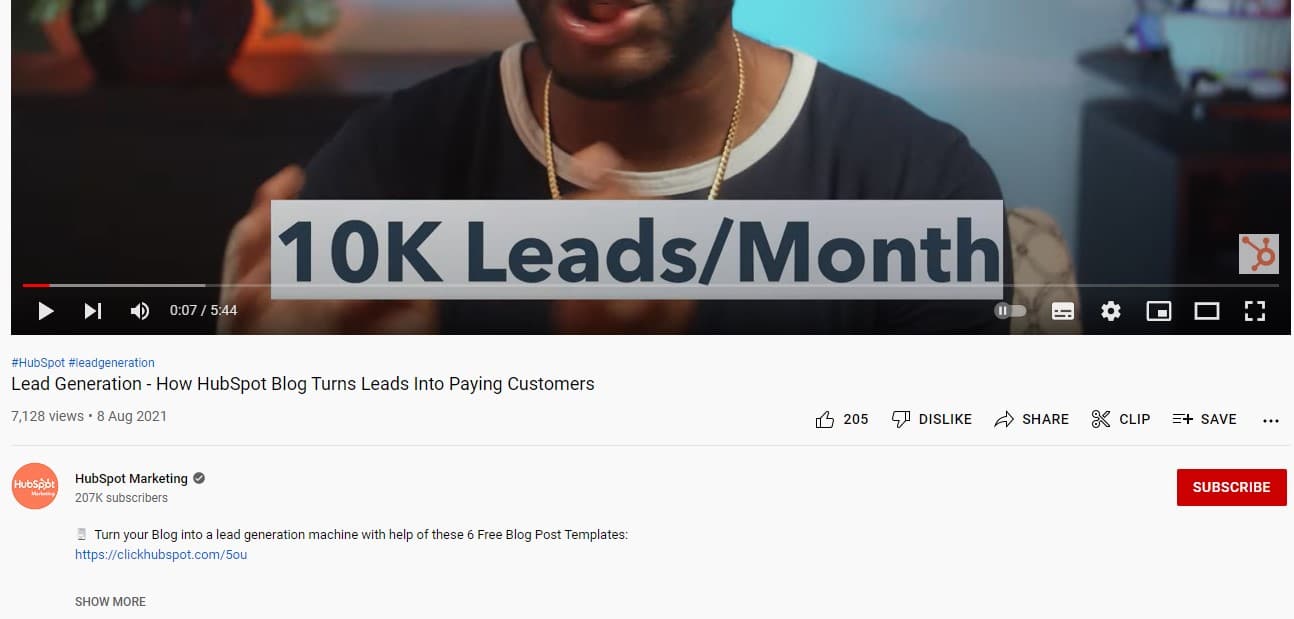
3. Start with Easy to Rank Keywords
The next super important B2B SEO practice or tip is to start targeting easy-to-rank keywords before you jump into the more competitive keywords.
The thing is, you want to start generating organic traffic as soon as possible, but if you are just started or your website authority is low, targeting highly competitive keywords will not get you anywhere.
For example, when I started my blog, I only target the juice but super competitive keywords. That’s why my average position is so bad and I cannot drive any organic traffic.

No wonder, when is the last time you visited a website that ranks on the 8th page of Google?
And even if you look at my keyword rank tracking over 70% of my keywords even don’t rank.

That’s why even with over 100 articles I rank only for a few keywords. However, I should be ranking for at least 5,000-25,000 keywords with 100 articles.

So, avoid this huge SEO mistake. Don’t target highly competitive keywords first but start with the easy-to-rank keywords and work your way up once you have higher website authority.
For example, if your website authority is 40 according to your SEO tool like SE Ranking.

Then I recommend targeting keywords half of your website authority as a rule of thumb. In this case, it would be 20 and below.

As you can see, most of these keywords are long-tail keywords as usually long-tail keywords are easier to rank for in most cases.
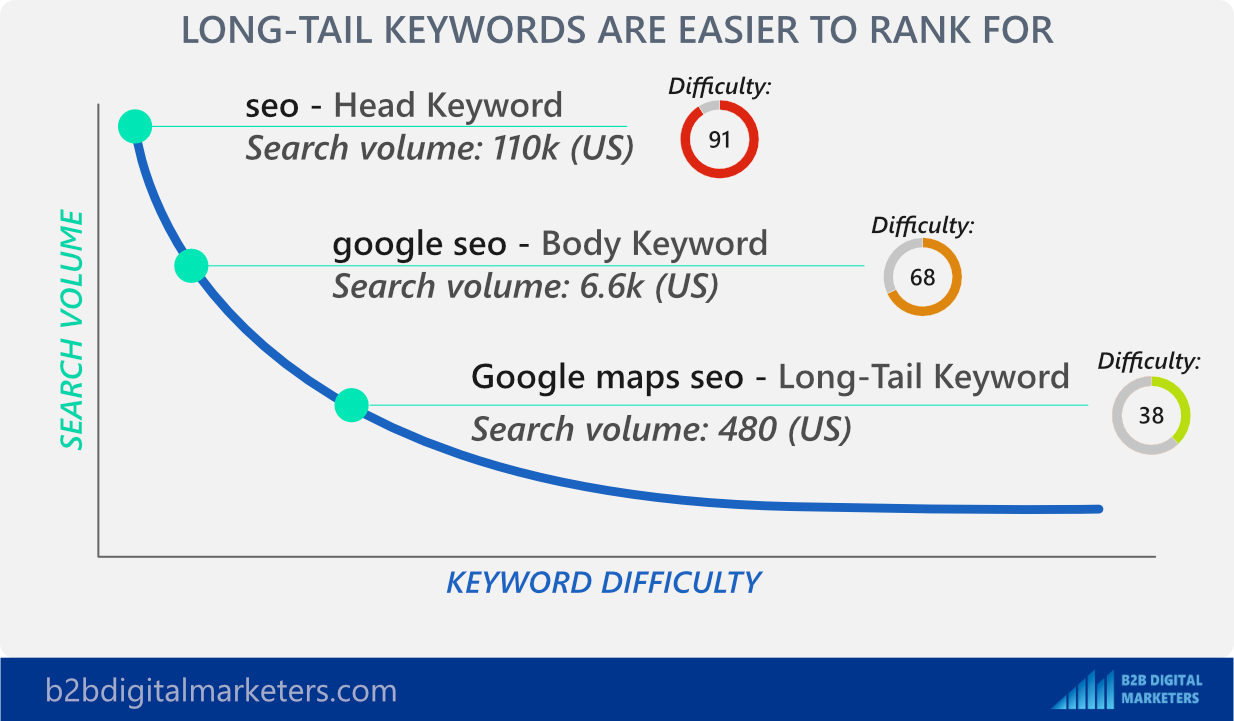
Of course, this is just a quick tip, but there are more factors you should check when you are searching for low competitive keywords such as the website authority of the top-ranking domains and how many backlinks the ranking page have.
For example, the keyword “keyword stemming in seo” has only keyword difficulty 10, which should be effortless to rank in the top position.

But if I use the SE Ranking SERP analyzer, for this keyword I can see the top-ranking pages are very high authority and there is no way I can rank in the top position.

And because this keyword has a tiny search volume, then the only ranking positions that would drive any organic traffic would be only the first two positions in SERP and anything below wouldn’t drive any organic traffic.
But if the search volume is like 1,000+ then ranking anywhere on the first page of Google would still drive organic traffic to your website. Of course, the better ranking the more organic traffic, but, even if you rank in the last position on the first page, you would still drive at least some organic traffic.
However, if the search volume is so tiny, then I need to rank #1 in the SERP for the keyword otherwise I won’t bring any traffic.
And unfortunately, in some industries like SEO, most of the easy-to-rank keywords have tiny search volume.
With that, it’s super important to target easy-to-rank keywords first, but you cannot rely on the keyword difficulty in SEO tools only and ultimately you need to see what pages are ranking at the top.
4. Always Optimize for Keyword Placement
Another important B2B SEO best practice on this list is to always optimize your content with the right keyword placement.
Despite technologies like Natural Language Processing, Multitask Unified Model, PageRank, Neural Matching and others to help Google better understand the content on a webpage, Google still is looking for keywords on your website to improve the indexing of your pages.
As said by John Mueller:
“So that’s something where, from an SEO point of view, if there’s something you want to rank for, I would still mention that on a page.
I wouldn’t go overboard with the number of mentions. I wouldn’t go overboard with all of the synonyms and different ways of writing it.”
With that, you can see adding keywords to your content is still important, so Google can better understand your content and rank it accordingly.
John Mueller also said:
“So… I would recommend that if there’s something that you want to tell us that your page is about, to make that as visible as possible.”
That’s why if you are targeting certain keywords, then adding keywords in certain aspects of your page where Google is looking for them will help you to improve your ranking and it will make it easier for Google to rank your content.
That’s why, here in this infographic you can see the most common places where you should place your keywords:
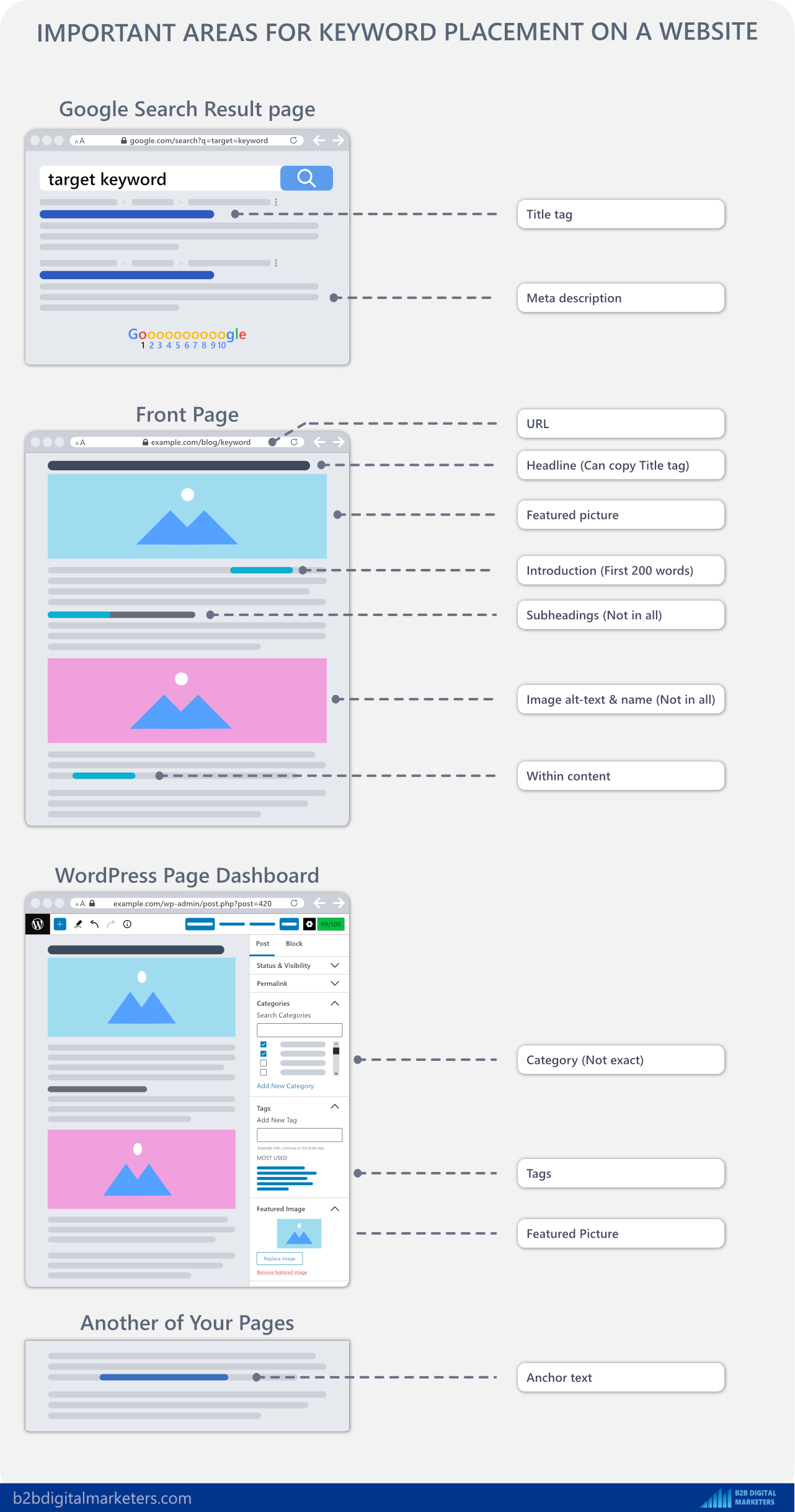
However, as John said, don’t worry about stuffing your keywords and keyword density. Usually, if you are writing in a natural way and have in mind what keyword you are targeting, you will naturally include it within the content.
Just make sure, you included the primary keyword in certain areas displayed in the infographic and mention them at least a couple of times in the body of the content.
Also, if you’re using WordPress, then check out my guide on where and how to add keywords in WordPress.
5. Always Create Internal Links
Another super important and often forgotten or ignore B2B SEO best practice is to always create internal links to your page and from your page.
Domain cross links are arguably one of the most important Google ranking factors that you have absolute control over and they can hugely influence your ranking, impressions in Google searches, time on your page and so much more.
For example, I have run a little experiment on my website. As you can see in this picture, once I have focused on the internal linking strategy, my website impressions in Google searches skyrocket. Then I deleted around 50% of my internal links and my impressions sunk like Titanic.

And this is not just me, but I have seen this happening across many different websites used by Agencies to get quick wins.
And the reason for that is that Google uses internal links in many different ways:
- Google uses internal links to crawl your website.
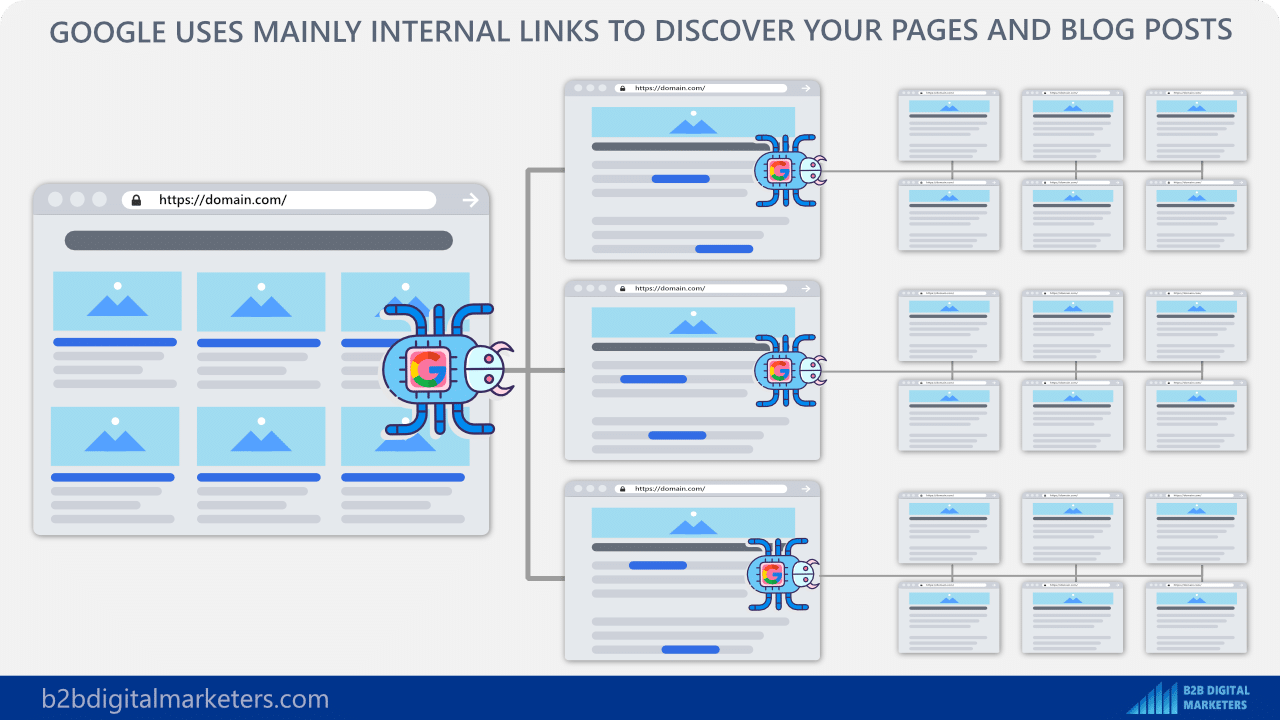
- Google uses internal links to understand the importance of your pages. The more internal links it has, the more valuable it seems to be for Google.

- Google passes PageRank via links, this is a direct way to improve your ranking.

- Google uses internal links to better understand your pages.

And all this will affect how your website performs in the search for your target keywords. That’s why if you have been slacking on internal links, make sure you start optimizing your website with a proper SEO internal linking strategy.
6. Remove any Duplicated Content
The next B2B SEO best practice is to remove duplicated content on your website.
Duplicated content can cause a lot of problems for search engines and webmasters as well and if you want to ensure that you have applied the best SEO practices, you deal with them.
Now, when it comes to duplicated content, there can be two versions of that:
- Within your website: This is when you have two identical pages on your website. This often confuses search engines on which one to rank, plus you might be wasting your crawl budget.

- Outside your website: This is when different websites copy content from your website and publish it on their own website. This can be a huge problem as they can over-rank your original content and steal your traffic. Even worst you might get a manual penalty for duplicating content.

However, in this case, we are talking about duplicated pages within your website.
Duplicated content can negatively affect your search engine performance and Google even stated:
“Google tries hard to index and show pages with distinct information.”
Therefore, if you are having a lot of duplicated pages, it can cause problems such as:
- Penalty
- Fewer indexed pages
- Less organic traffic
That’s why ensuring you don’t have duplicated content or adding the necessary code to canonicalize these pages will help you avoid these problems.
Often in eCommerce stores, this happens with filters where the results are not being canonicalized to their root category resulting in tons of duplicated pages.
Also, be aware of the search function on your website, those search result pages can get indexed too. Again, this can easily add 1,000+ pages to your site. All of which contain duplicate content.
7. Create Standardized SEO URL Structure
My next B2B SEO best practice or tip is to standardize your SEO URL structure.
The structure of your website and URLs is one of the most fundamental building blocks of SEO strategy and the better and easier you make them understandable the better the results tend to be.
SEO-friendly URLs can help search engines and users to better understand your content even before they visit the page.
For example, if you are providing link building services, then having a structured URL like this will easily show that to search engines and users.

Instead of having a random page id.

That’s why you should have your product pages under the product category, service pages under the service category, blog posts under the blog category, et cetera.
Not only that but neat-looking URLs make your web pages look less spammy, especially if you share them on social media.
Plus, as stated by Google about URL structure:
“A site’s URL structure should be as simple as possible.
Overly complex URLs, especially those containing multiple parameters, can cause problems for crawlers by creating unnecessarily high numbers of URLs that point to identical or similar content on your site. As a result, Googlebot may consume much more bandwidth than necessary or may be unable to completely index all the content on your site.”
On top of that, including keywords in URLs is still being considered a small ranking factor confirmed by John Mueller.
That’s why if you look at any of my blog posts or even web pages, I only include the primary keyword in the URL and nothing else to keep it simple and easy to understand what’s the page about.

With that, there is a lot more about creating SEO URLs, so you can watch my video right here:
8. Focus on SEO-Friendly Headlines
The next on the list of B2B SEO best practices is to focus on writing SEO-friendly headlines.
Headlines are one of the most important elements on your website as 8 out of 10 people read your headline while only 2 out of 10 people read the content.

Not only that, but headlines are used by search engines to better understand your content and match it to what users are looking for and headlines are a strong ranking factor.
As said by John Mueller:
“And when it comes to text on a page, a heading is a really strong signal telling us this part of the page is about this topic.”
This of course means any heading, whether it is your headline (h1) or subheadings (h2, h3).
Using a heading will help Google to better understand what a section of content is about which of course can result in a better understanding of the content and rank it better.
Therefore, every time you are creating headings, think about it as providing a hierarchical structure where you can nest several related subtopics within a bigger topic.
9. Focus on Dominating in Local SEO
My next B2B SEO best practice is to focus on dominating local SEO.
Local SEO is arguably one of the most powerful types of SEO for B2B organizations in terms of generating leads and having a high chance of ranking for highly competitive keywords in your local area and outranking massively authoritative websites.
For example, I have been able to outrank Microsoft with Local SEO for their own product, which resulted in generating a massive number of leads from the local area.
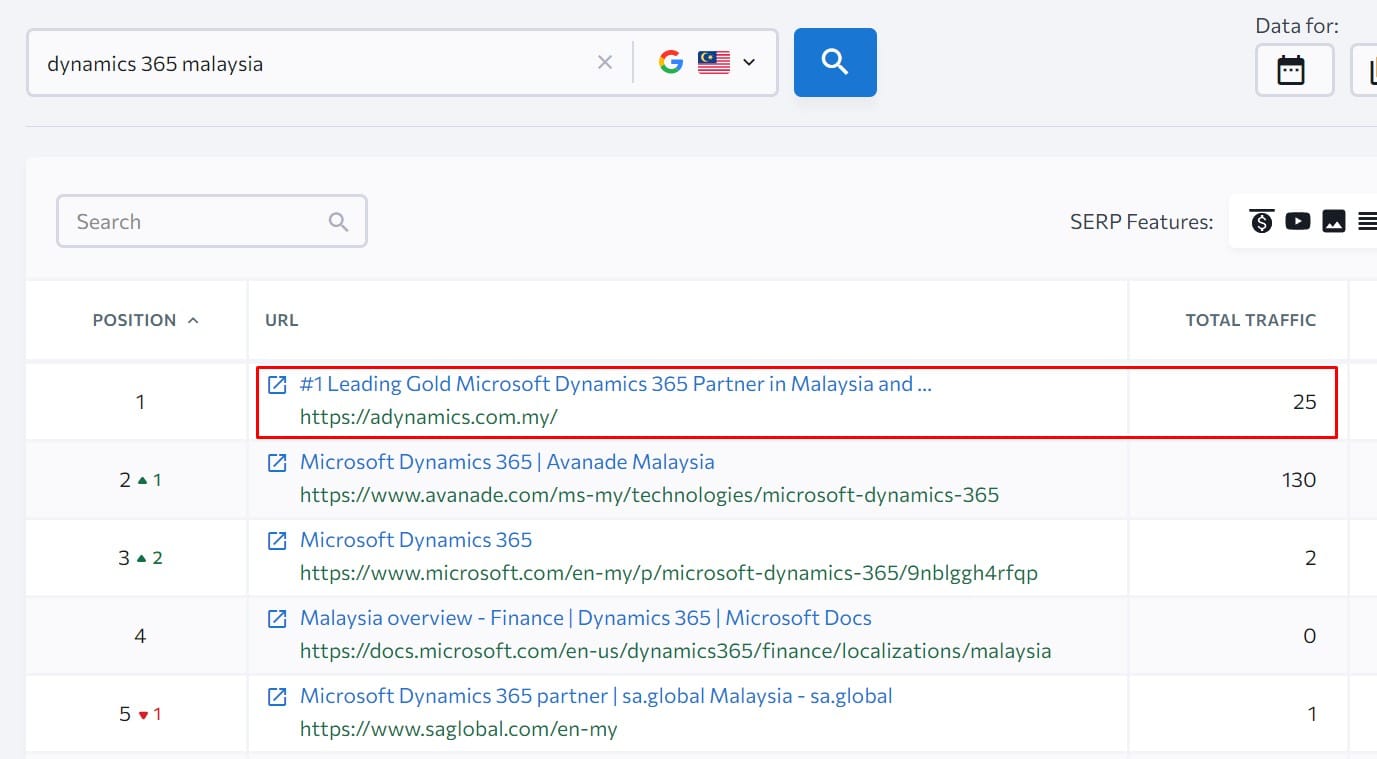
And the website has only a tiny website authority compared to Microsoft.

B2B Local SEO is arguably one of the most powerful digital marketing strategies for every B2B company. In fact, 46% of all searches in Google have “local intent” and in most cases, companies preferred to buy from a local vendor, whether it is services or products.
Therefore, the phrase “think globally, act locally” absolutely applies to B2B SEO and generating leads as it will allow you to drive very relevant and highly targeted local organic traffic, that converts way better than the general global SEO traffic. This strategy is also excellent when you want to sell leads.
10. Properly Optimize Your Images for SEO
The next on my list of B2B SEO best practices and tips is to always make sure you properly optimize your images for SEO.
By adding images to your content, you can greatly enhance the user experience, improve your conversions, help users and search engines to better understand your topic and what you are talking about and so much more.
And most website owners already understand that images are an essential part of every web page, whether it is a product page, blog post, or any other page on their website.
Images make your content better. But they can also improve your B2B SEO by driving more organic traffic, attracting high-quality backlinks, and providing more information for users and search engines.
So, to boost your B2B SEO results with images here are some image SEO best practices:
- Use web-friendly image formats: Use formats like jpg, png, webp, or svg to get the highest quality images on your website.
- Keep the image size small: Not only these pictures are very high quality, but they can also be easily compressed without losing their quality. I recommend keeping your picture size below 200kbs.
- Create unique informative and infographic types of pictures: Creating helpful pictures can often help you describe complicated things much easier. Plus, they can be a great source of getting backlinks to your website.
- Add primary and secondary keywords in your images: Google scans your pictures. Thus, adding your primary and secondary keywords in your image names and alt-text can help Google to better understand your content. Plus, it improves your ranking in Google image search which can bring additional traffic.
- Create descriptive names and alt-text of your images: Make sure each picture on your web page has a relevant, unique, and descriptive name and alt-text. I usually use the same description for the image in the alt-text and name. But if you want to be proactive you can create different for each of those.
- Ensure lazy load for your images: Lazy load ensures your pictures only load when users scroll to them. This can significantly improve your page speed.
- Add images to sitemap: Ranking images can be a great additional source of organic traffic. By using an SEO plugin like Rank Math, you can easily add every image on your website to a sitemap and improve their ranking.
Also, here you can see a helpful infographic that you can use as your Image SEO checklist:

11. Add External Sources on All Blog Posts
Another important B2B SEO best practice I have for you is to add external sources to all of your blog posts, especially when you are making claims or sharing ideas.
According to Brian Dean, an SEO expert: “Not linking out might be the #1 on-page SEO mistake.”
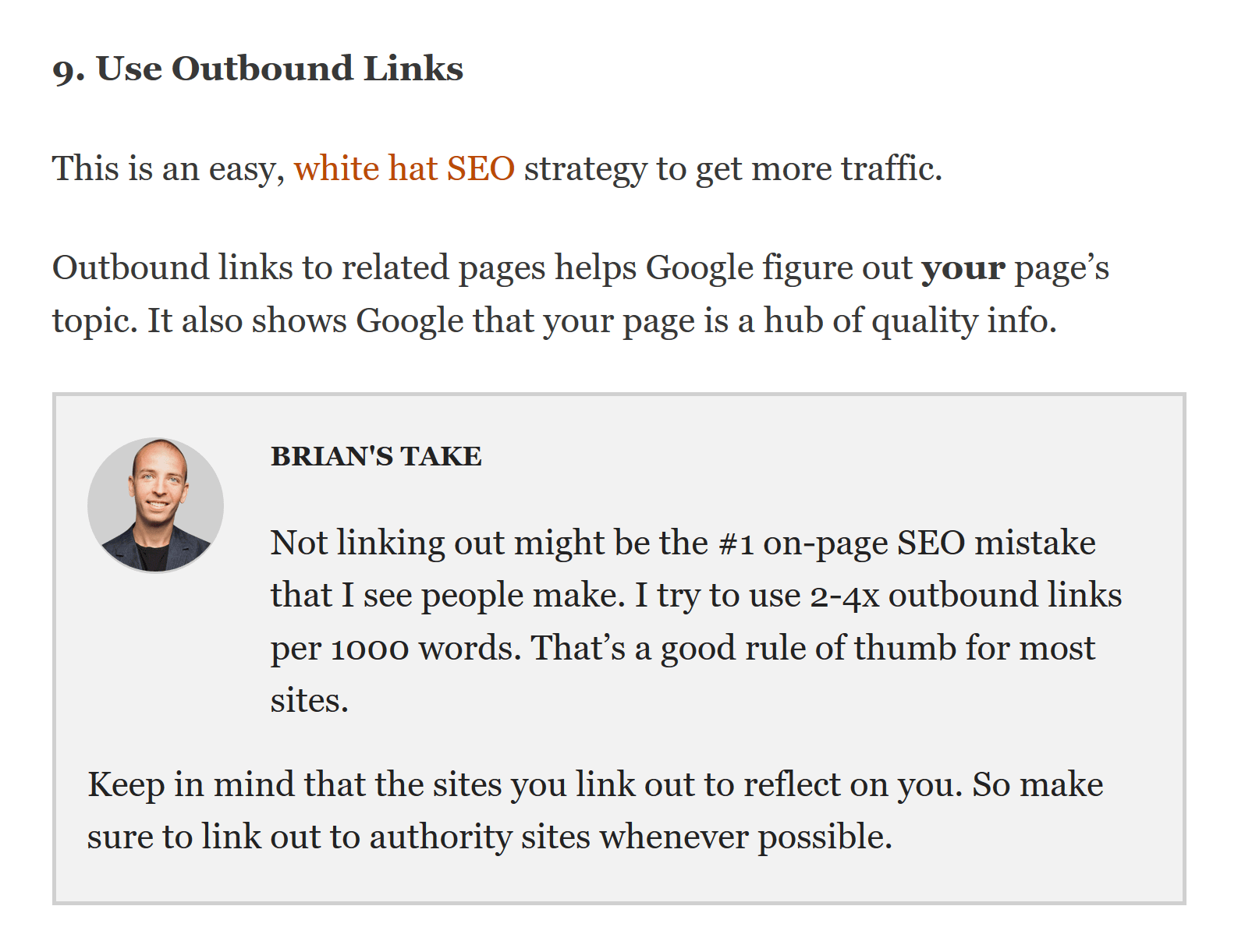
Also, Google in their Search Quality Guidelines for their underpaid quality raters specifically encourages their quality rates to search for external references to further establish E-A-T of a page.

With that, here are some of the benefits of including external links in your blog posts:
- Improve digital footprint: You are essentially building a history of links between your site and more established ones. As SEO expert Rand Fishkin says, ups “the potential to attract important, relevant, valuable eyeballs.”
- Improve the quality of a page: Adding external sources to prove your claims and provide more information related to the discussed topic in the blog post, can improve the quality of the content.
- Increase the credibility of your content: By adding external links to relevant information, you show your readers you are knowledgeable in your field, and that you know what’s up. It also shows you care about providing high-quality information within the field or topic you are discussing.
- Improve your E-A-T: Adding external links to external sources, especially to research papers or highly authoritative sites like Harvard can improve your E-A-T. Especially if you are in YMYL niches like personal finance, health, medical et cetera. This is super important to do!
- Improve relationship and expand your reach: Trust me, almost every site is checking new backlinks on regular basis, and seeing a new backlink from your site, can prone them to check out your website as well.
Of course, you also should be careful about linking out as it can hurt your SEO performance as well. For example, you don’t want to:
- Have 404 codes in your external links: Redirecting your users or search engines to non-existing pages does not look good for your website and it can hurt your SEO performance.
- Link in an unnatural way: Be very careful to link out just for sake of linking out or as a link exchange, it can get you penalized.
- Link to shady-looking website: The websites you are linking directly reflect your reputation. Do you want to be associated with shady-looking websites?
- Avoid linking to adult websites: Unless you are in such an industry it’s highly recommended to not include external links to adult websites like casinos, betting sites, et cetera.
- Have too many external links: While having external links can be good, try to limit them. You still don’t want to distract or lose your readers.
However, Google has denied that they use external links as a ranking factor as adding links outside of your website doesn’t guarantee the website is high quality and it would become an artificial factor that can be easily manipulated.
But it is still an easy white hat SEO strategy that you should implement for your B2B SEO.
12. Have Real Authors on Your Blogs
My next B2B SEO best practice is to have real people as authors, preferably your subject matter experts should be the authors of your blog posts.
I believe if you are writing blog posts it should be similarly created just like a research paper but without the overly complex sentences that no one understands and instead of that using 6-7 grade level writing in your language.
However, most of it should be the same such as including external references and the article should be associated with an author that has written the piece of content.
That’s why Google is looking at the authors of blog posts using a number of different factors and with E-A-T, expertise and authoritativeness are characteristics that Google uses to evaluate the author.
And with the recent Google patent called Author Vectors Google is trying to better understand who wrote which articles suggesting that Google still cares about authors.
And even in Google Quality Rater’s Guidelines Google emphasizes the reputation of the author who wrote the content.

That’s why it is suggested to have author pages and relevant links to their social media, websites, and other places where they are active to better understand the author’s expertise.
With that, we still don’t know why or how Google is using the authors of blog posts in their algorithm, but even if Google does not look at the authors of the content, it still brings benefits such as:
- Increased credibility of the website: Seeing an author behind the article increases credibility. According to Kent State University, a listed author is one indication of a credible site. Also, 96% of people perceive blogs with multiple authors to be more credible
- Improve brand trust: People like to see who wrote the article. If you visit a blog post without an author, it seems fishy.
- Authors can act as influencers: Active authors whether on social media or other websites can further promote your website and get you more readers.
- Increase website authority: If you are having subject matter experts writing your blog posts, then you can find that other websites might refer to your author within their articles which means more juice backlinks for your website.
13. Improve Click Depth
Another B2B SEO best practice I have for you is to improve your click depth or how many clicks it takes to go from your homepage to another page on a website.
Your click depth directly reflects how well you have planned your SEO website architecture and internal linking structure, especially if you have done right your category or hub pages.
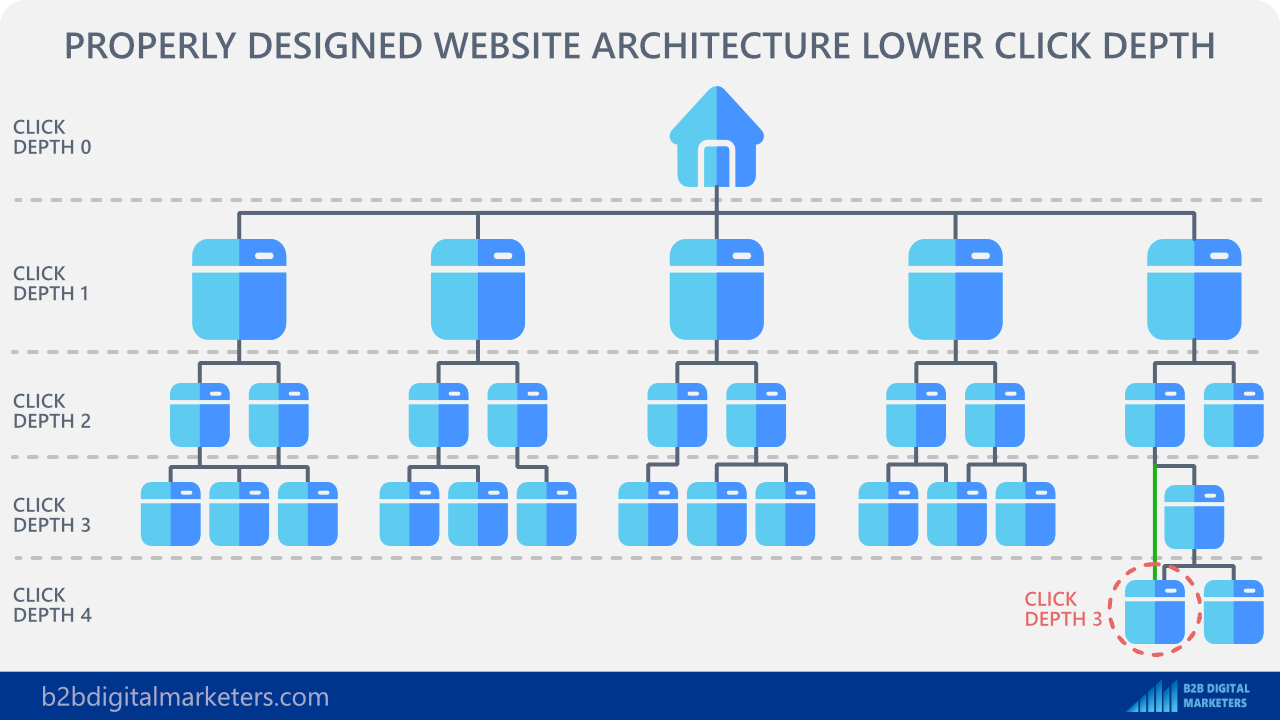
For example, are all your product pages accessible from the product category page or all your service pages on the service category page?
With category pages, you can easily and semantically connect your web pages to help search engines better understand your content and users easily find what they are looking for on your website.

It will also help you remove any orphan pages or silos of orphan pages.

With that, I recommend keeping your web pages at a depth of no greater than 3 as like this you will be able to spread your link juice equally across your website and improve your overall ranking.
To check your click/page depth you can use SE Ranking Website Audit tool and click on the number to display pages with the page depth. For example, I want to see what pages of mine are in the page depth of 4. (Learn more about B2B SEO audit for your website.)

And this will automatically select those pages that have page depth 4.

Or I can add a filter and select depth to filter all the pages that have a page depth greater than 3 to fix them all.

Now I only need to improve my internal linking structure in order to push those pages to page depth between 1-3.
14. Be Careful How You Build Your Links
And the last and super important B2B SEO best practice on this list is to be careful how you build backlinks to your website especially if you are doing tiered link building.
Backlinks are arguably one of the best ways to improve your ranking and drive more traffic and leads from your SEO strategy, but also one of the best ways to get penalized by Google.
That’s why you should be extremely cautious about how you build your backlinks. So here you have some of the link building best practices:
- Build backlinks on the website with organic traffic: Organic traffic is a great indication of Google trusting the website. That’s why I recommend you build backlinks on the website with minimum organic traffic of 1,000 according to your SEO tool. If you don’t use it, then I recommend SE Ranking.

- Avoid sites with “Write For Us”: Google hates guest posting and automatically devalues them and sites with the “write for us”, “guest article”, “guest post opportunities” and others are just easy targets for Google and for you not getting any benefit from it.
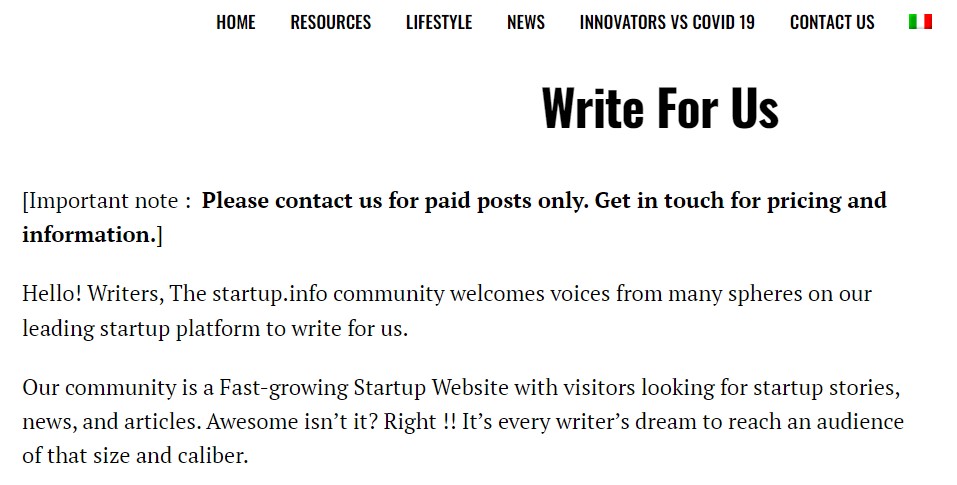
- Build backlinks on a website with similar authority: Of course the bigger sites, the bigger the reward from the backlink, but also they are harder to get and if you are a smaller website you are just killing your chances. So first, start with a website with similar website authority and work your way up.
- Focus on the location of the organic traffic: The location from which a website, that you built a backlink on, generates most of the organic traffic will influence your organic traffic as well. For example, if a website generates most of the organic traffic from India, which means this is where their ranking is the best, and you get a backlink from that site, it will directly influence your ranking in India. That’s why it’s important to build backlinks on sites that generate most of the organic traffic from the location you target.

- Balance the anchor text ratio: One of the biggest link building mistakes and the fasters way to get penalized is to build only keyword-rich anchor text backlinks. That’s why you should follow the optimal anchor text ratio when building backlinks. Here is mine:
- 50% Branded, personal & URL anchor text
- 20% niche and general relevant anchor text
- 20% miscellaneous anchor text
- 10% target, synonym, and long-tail keywords anchor text.
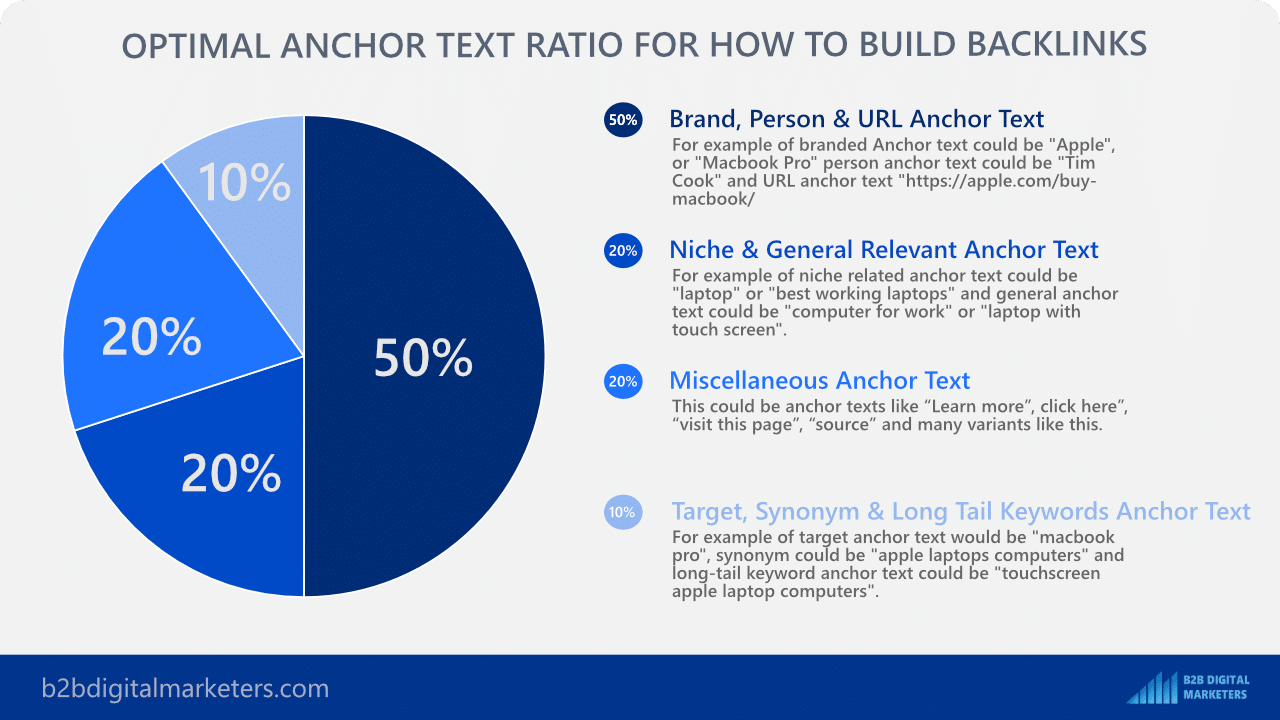
- Build backlinks on sites that write on similar topics like you: If you are in the gardening niche, then you want to get backlinks preferably who are in the gardening niche as well or from similar sites that target topics close to yours.
So, when you are building backlinks for your website, be careful to avoid these common pitfalls so you don’t get penalized and get the most out of your link building campaign.
Final Advice
When it comes to B2B SEO there are a lot of nitty little things you can get stuck on. However, the most important part of B2B SEO is to become the authority within your field, which means, targeting as many keywords within your niche or industry, providing highly valuable and unique content, providing excellent user experience, and becoming cited site across news and other sites.
If you achieve this, you will see amazing results from your B2B SEO and you will drive enough leads to do well.
Did I forget something, is there any other B2B SEO best practices and tips you particularly like? Let me know on my YouTube channel, cau!
Related Articles:
- SEO for Landscaping: Ultimate & Easy Guide for Non-SEOs
- How to Find Keywords on a Website
- Competitor Research Tool: 12 Best Ways How to Use It
- Blog SEO: Best Tips & Practices to Get You Started
- Resource Link Building: Complete Guide You Need
- Off-Page SEO Activity List: Increase Online Reputation
- B2B Blogging: Best Practices, Tips and Tricks
- B2B Keyword Research: Bring Leads & Revenue from SEO
- 12 Best Digital Marketing Strategies
Also, check out our SEO hub page to find all our SEO resources.
Disclaimer
Some of my links are affiliate links, which means if you purchase something, I might get a small commission as a reward for reference. Of course, I am actively using all these services and products, and I only affiliate products or services I have full trust in their quality!
Disclaimer
This article was created by Eduard Dziak and may contain affiliate links. The following were used to optimize the article for the best user and search engine experience include:
- SE Ranking for keyword research and on-page SEO optimization
- Surfer SEO for SEO-friendly content creation for users and search engines.
- Jasper AI for grammar correction and information enhancement.
The article is based on the author’s own experience and knowledge, drawn from both their own work and that of their clients, to provide the latest, proven methods.








